Effective and Affordable House Wraps
New textured and breathable weather-resistant barriers maximize drainage capabilities and protection against water and air infiltration
![]() Continuing Education
Continuing Education
Use the following learning objectives to focus your study while reading this month’s Continuing Education article.
Learning Objectives - After reading this article, you will be able to:
- Discuss the ways in which house wraps contribute to moisture management and enhance green building goals.
- Compare various types of weather-resistant barriers in terms of their ability to effectively minimize moisture and air infiltration and allow drainage of water in the wall cavity.
- Identify the key considerations in the proper specification of a house wrap product to ensure occupant health and safety and consistency with sustainability objectives.
- Explain how to overcome potential problems in the installation process in order to maximize the effectiveness of the specified house wrap material.
Moisture intrusion. It has bedeviled builders and homeowners for centuries. Moisture in the building envelope can cause problems for the structure and its occupants, including rot, mold, mildew, and microbial growth. Left untreated, unwanted moisture can jeopardize a building's integrity, leading to customer dissatisfaction, callbacks, and, in some cases, even structural failure, litigation, significant claims against builders, and expensive repairs and remediation. Compounding the problem is that even severe moisture damage can occur without telltale signs.
In recognition of the potential pitfalls associated with moisture intrusion, building codes are becoming stricter with regard to moisture management, and building architects and owners more attuned to the often onerous implications of improper moisture control. Many in the building community rely on house wraps, or weather-resistant barriers (WRB) to prevent moisture entry into the wall cavity and to create continuous protection around the structure, covering gaps, cracks, and other holes between the sheathing and the cladding. Over the years, house wraps have evolved, with some of today's versions better able to also protect against air infiltration and easily drain any water that has penetrated the wall cavity, and allow water vapor to escape the home—all at an affordable price. This article will highlight the basic characteristics of house wraps, compare the various types of house wrap products on the market, and identify the features to consider in properly specifying a house wrap in a residential structure.
House Wraps: The Basics
While many builders and homeowners assume that the siding on a house is sufficient protection against water infiltration, this is not the case. Even perfectly installed, high-quality siding cannot perform that task, as water, particularly wind-driven rain, will inevitably find its way through gaps and cracks in the wall assembly. That goes for all claddings—reservoir claddings like stucco as well as wood, insulated vinyl, or fiber cement all have the potential to hold trapped moisture.
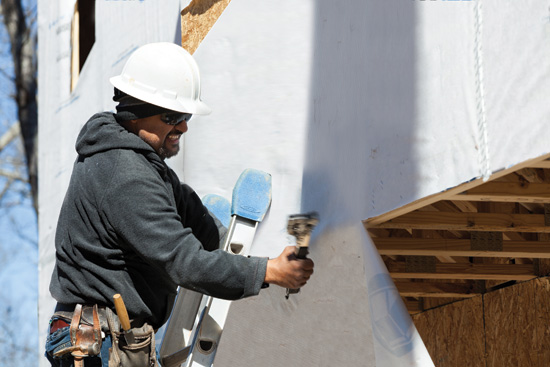
Photo courtesy of Kimberly-Clark
Many in the building community rely on house wraps, or weather-resistant barriers (WRB), to prevent moisture entry into the wall cavity.
Over the years, it has become common practice to install a weather-resistant barrier (WRB) between the sheathing and the cladding as a second line of defense in moisture protection. A WRB, or house wrap, is a lightweight synthetic material which, if properly designed and installed, will protect the structure from weather, moisture, and other environmental damage over time. Specifically, a house wrap has a threefold task: stop liquid water intrusion; be sufficiently vapor permeable to promote drying of the wall cavity while allowing water vapor to escape outside of the structure; and prevent air infiltration into the structure. In other words, an effective house wrap will assure that bulk water is not admitted to the wall cavity, and any water that does breach the barrier is quickly drained, allowing the wall system to dry out, and drafts are avoided—all of which work to favorably impact structural integrity, the service life of the building, indoor air quality, and energy costs. Permeability is a key consideration as, if water is left to collect within the walls, not only is the possibility of mold increased, but the built up moisture will almost certainly compromise the R-value of the insulation. To be considered effective, a house wrap product should possess a relatively high moisture vapor transmission rate.
If they are properly sealed, house wraps can also serve as an effective air barrier. In fact, preventing air leakage can be a key part of a house wrap's contribution to sustainable building.
According to Franklin & Associates in a study prepared for the American Plastics Council, house wraps are “quite effective at reducing air infiltration.” As the U.S. Department of Energy (DOE) maintains, because some 50 percent of heating and cooling energy for homes stems from air infiltration, it follows that blocking that infiltration has the potential to reduce energy usage and related greenhouse gas (GHG) emissions. While the study acknowledges that the evidence is “highly variable and dependent on many factors,” the amount of air house wraps can likely block falls in the range of 10 percent to 50 percent of the infiltrated air, with “the reduction in energy consumption of a typical house in the U.S. as a result of applying house wrap is estimated to be 12 to 60 million Btu per year. Over a period of 30 years, these values become 360 to 1,800 million Btu.”1
The DOE, in fact, cites house wraps as the most common air barrier material, and notes that sealing the house wrap joints with the manufacturer's tape can boost the material's performance by some 20 percent.2 House wraps can also help the home to qualify for and maintain ENERGY STAR® certification.
Most structures, regardless of whether they are stick built or metal framing, commercial or residential, single or multi-level, should use some type of weather-resistant barrier. House wraps are necessary protection in all wood-framed residential structures and most are applicable in multifamily residential structures up to five stories high—beyond that height limit a commercial-grade wrap is needed as typical house wraps are subject to tearing from wind forces. The exterior of the structure should also be taken into consideration when selecting a house wrap. Reservoir claddings that absorb and store water such as stucco, brick, and stone all pose serious concerns in regard to water penetrating into a wall assembly—walls should be built with an air space behind these types of cladding.
Types of House Wraps
There are several types of WRB—asphalt felt, Grade D building paper, plastic house wrap, and liquid-applied WRB, among others. Tar paper, or felt as it is now referred to, was the preferred choice of WRB many years ago. Felt has evolved from a heavy, unwieldy material to a lighter, water-resistant material. While some builders prefer it, felt is still relatively heavy, and is susceptible to punctures, and the fact that it traditionally comes in 3-foot-wide rolls makes it somewhat cumbersome and time consuming to install. Advocates note that if wet, felt is absorbent and will gradually dry. Most often used in the western U.S. and under stucco, grade D paper is a lighter-weight, lower-cost asphalt-saturated paper. Grade D paper has a minimum water-resistance rating of 10 minutes, with many manufacturers far exceeding the minimum requirements. Still, if Grade D paper becomes and stays wet, rot may occur. Liquid-applied WRBs are another option. Sprayed or rolled on sheathing, they form a coating that is air tight and resistant to water penetration. One drawback with liquid-applied materials is their high cost relative to other alternatives. A consistent thickness must be achieved, adequate attention paid to detailing, the proper cure time observed, and protective clothing worn during the application process. Air and water resistant, liquid-applied materials vary as to vapor permeability effectiveness.
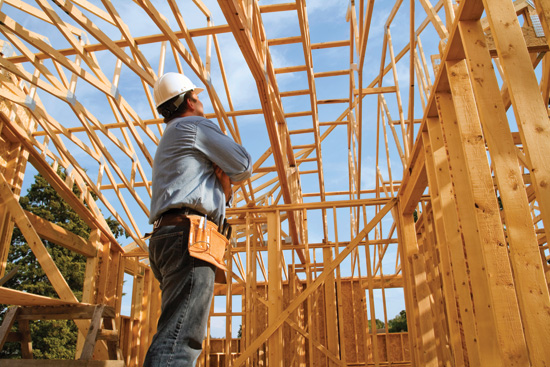
Photo courtesy of Kimberly-Clark
Installing a WRB between the sheathing and the cladding is a second line of defense in moisture protection.
Modern House Wraps
In use for more than four decades, plastic house wraps provided an alternative to asphalt-saturated felt. Because WRBs come in rolls that are wider than asphalt—9 to 10 feet being the industry standard—they can be installed more quickly and easily. Fabricated from woven or non-woven polyethylene or polypropylene in various processes, a plethora of modern house wraps are available with a range of water resistance, water permeability, performance and durability characteristics. House wraps can be woven or non-woven, which are typically sheets bonded together chemically, thermally, or mechanically. They can be further categorized as perforated or non-perforated. While some house wraps are manufactured for natural permeability, others rely on small holes to provide permeability. In other words, to achieve water vapor transfer some house wraps have micro-perforations while others are micro-porous, having the technology to allow water vapor to diffuse through the fibers of the fabric itself, helping to remove trapped moisture within the structure.
Unlike non-wovens, most woven products typically achieve vapor permeability though the use of micro-perforations. While micro-perforations do add to a material's breathability, they tend to compromise its resistance to liquid water penetration and air flow, presenting the possibility of water damage and negative implications for the integrity of the insulation and associated energy costs.
Next-Generation House Wraps
In contrast to traditional house wraps that only provided a water-resistive layer that could trap water in the wall cavity, the emphasis today is on drainable house wraps which provide a drainage gap that allows water to exit the wall cavity as quickly as possible, resulting in a dramatically better removal of water from a wall system.
Next-generation house wraps do not sacrifice breathability for liquid water resistance, or vice versa, with manufacturers claiming these materials can prevent water penetration while providing a breathable barrier technology that allows moisture vapor from inside the home to escape, maintaining a dry building structure for long periods of time. Breathability in a house wrap is critical particularly when considered in light of the fact that, in an average household, occupant activities from breathing to bathing to cooking emit up to 6 gallons of moisture a week—that water has to go somewhere. If the house wrap does not breathe properly, the moisture will escape through the walls, and enter the wall cavity where it is stopped and trapped if the house wrap is non-breathable, the result of course being the potential for degradation of many commercial insulation products as well as for rot, mold, and eventually, structural failure.
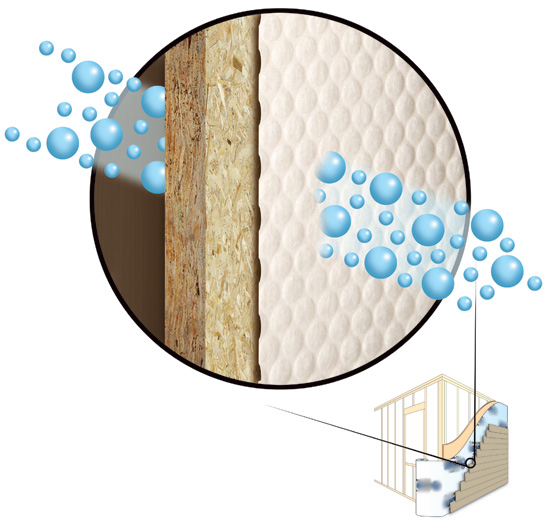
The vapor-permeable membrane allows moisture in the building to escape, protecting the structure from rot and mold.

As an air barrier, a house wrap helps to reduce heating and cooling cost.
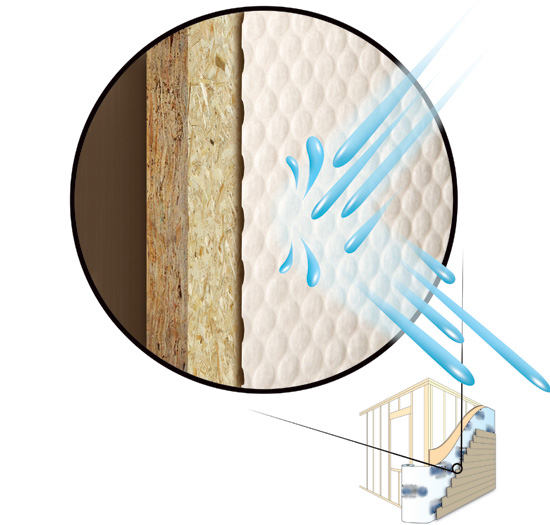
Images courtesy of Kimberly-Clark
House wraps act as a barrier, keeping wind-driven rain and other water from reaching the sheathing.
Products fabricated in the form of cloth-like, non-woven water-resistant barriers use a patterned, grooved, dimpled, or otherwise textured surface to create a breathable barrier and improve water drainage within the wall. Rather than lie flat against the siding, the vertically textured material forms a thin air space that acts to encourage the channeling of any liquid that reaches the siding of the home to quickly drain out to the ground. These textured house wraps have achieved impressive drainage rates, with some demonstrating a 98 percent efficiency in liquid drainage.
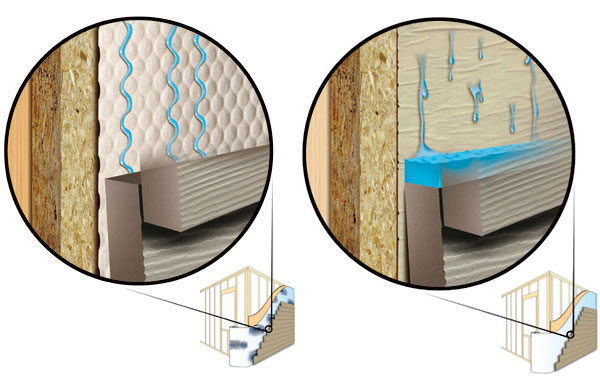
Images courtesy of Kimberly-Clark
Textured house wrap (figure on left) protects homes by channeling water away from wall structures and to the ground. On non-textured house wrap (figure on right), water vapor condenses on house wrap and runs down, pooling on top of the siding or in the folds and wrinkles of the wrap. This moisture can lead to mold and rot of the wall assembly.
As can be seen in the above comparative illustration in which house wrap is attached to oriented strand board sheathing on top of 2x stud framing, textured house wrap is superior to non-textured in terms of water drainage. The textured material channels water away from the wall structures to the ground, while water vapor condenses on non-textured house wrap and runs down, pooling on top of the siding or in the folds and wrinkles of the wrap. This trapped moisture can lead to mold and rot of the wall assembly.
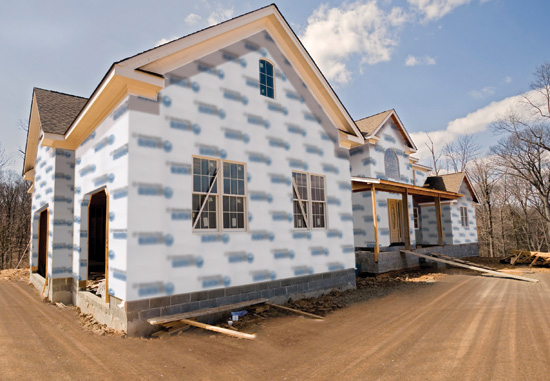
Photo courtesy of Kimberly-Clark
Next-generation house wraps resist water and air intrusion into the structure and allow water vapor to escape from the wall cavity, leading to more energy-efficient, sustainable homes.
While this level of performance may signal a product that is prohibitively expensive, that is not the case. Textured house wrap can be a mid-price product when the manufacturer has a firm control of costs, particularly when the product is fabricated in the manufacturer's own mills—an arrangement with favorable implications not only for pricing but for quality control as well.
Foam Sheathing and House Wrap
Foam sheathing is not an air barrier or a weather barrier. While foam sheathing may be an adequate, low-cost method for achieving the R-values required by the 2012 IECC, because it does not provide an effective water-resistant barrier, it fails to protect the structure in a comprehensive manner. Even when properly installed and taped, foam sheathing lacks the shingling effect necessary to keep water from seeping through the edges of the tape and into wall assemblies. Once those wall assemblies get wet, the ambient humidity both inside and outside the structure can make them tough to get dry, resulting in rot, mold, and eventual structural failure—all problems that have resulted in skyrocketing insurance claims that continue to plague builders. Some consider it best practice to install an effective WRB that can provide weatherization and breathability benefits that help maintain the as-constructed R-value of the home insulation. The right, properly installed house wrap can provide a superior air barrier to foam sheathing by itself, which can expand and contract in the heat and cold, causing tape seams to fail, which allows the air barrier to be broken.
As the building community becomes more aware of the advantages, the use of house wraps will increase in the coming years. Driven by building codes, regulations governing building envelope systems, and the move to construct energy-efficient homes and upgrade existing insulation systems, house wraps in fact are expected to see a surge in growth globally, according to consulting firm Frost & Sullivan, in its recent report entitled “Analysis of the Global House Wraps Market.” The firm found that the house wraps market earned revenues of $696.4 million in 2013 and estimates this to reach $1.05 billion in 2018, with user preference for the non-perforated house wraps projected to increase during the forecast period. Manufacturers providing a wide range of products with optimum price-performance stand to gain as do those with “efficient after-sales services, including on-site support, extended warranty programs, and product workshops will provide opportunities for market participants to speed up customer acquisition.”3 The study goes on to state that “the energy to manufacture house wrap for a single house is only 1.2 to 1.8 million Btu depending on the type of polyolefin used,” and that “compared to the energy savings resulting from the application of house wrap, the average 'pay back' period ranges from only 7 to 54 days.”
Specification Considerations
High-performance house wraps share several characteristics. They demonstrate high levels of air resistance, water resistance, vapor permeability, and durability both during and after construction. When choosing the right house wrap several factors should be considered:
• Climate – The amount of annual rainfall
• Exposure – Amount of overhang, altitude, trees, and building proximity to the structure, even the geographic orientation of the wall
• Cladding type – Wood, insulated vinyl, fiber cement, brick, stone, stucco, etc.
With more than a few brands on the market, it is important for architects to complete their due diligence. At the very least, how the product rates on industry standard tests should be closely examined, particularly those of the American Society for Testing and Materials (ASTM), whose more than 12,000 standards are in operation globally, and the International Code Council (ICC ), whose I-codes provide minimum safeguards for people at home, at school, and in the workplace. While generally speaking house wrap products will undergo such testing, a word of caution is in order. It should be noted that these tests are performed on small samples of the test material, not on real-world buildings in actual field conditions, making apples to apples comparisons difficult.
Durability, Pliability, and UV Resistance
A function of strength, pliability, and UV resistance, durability of a house wrap product is measured through the following tests.
ASTM D5034. Tests to determine a material's strength and tear resistance are important for house wraps, some of which rip and tear easily in handling and application during construction, or by contact with construction debris or high winds, or are susceptible to abrasions and punctures, and snags on tools and nails. A commonly used test to determine the breaking strength and elongation of woven, nonwoven, and felted fabrics and textiles is ASTM D5034, or what is known as the “grab test.” The test fabric is placed in a machine that is designed to measure the force required to tear it. The standard specifies that the Dry Breaking Force shall be a minimum of 40 lbf in the machine direction and 35 lbf in the cross-machine direction, though architects can expect newer products to score as high as 51 lbf in the machine direction, and 40 lbf in the cross-machine direction.
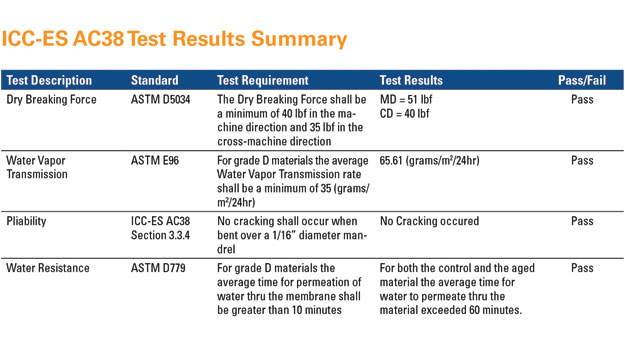
Table courtesy of Kimberly-Clark
This table indicates what a textured house wrap could be expected to achieve compared to the minimum standard required by various industry tests.
AC38 Section 3.3.4. Cold weather construction is a fact of life in many climate zones. Ideally, house wraps retain their pliability even in cold weather applications, and can be easily installed around corners and edges, at joints, and over complex architectural features even when the thermometer dips toward the freezing level. AC38 Section 3.3.4, also known as the Cold Mandrel Bend Test, will determine whether the material will crack at low temperatures. A sample of the test materials is conditioned to 32°F and then bent over a 1/16-inch-diameter mandrel. To conform to this standard, there should be no cracking of the material under test conditions.
UV stability also contributes to a house wrap's durability as small amounts of UV exposure can cause deterioration. Depending on the construction schedule and how long the period between wrapping the house and installing the siding, architects may want to consider products with UV inhibitors, which can minimize this pitfall. Manufacturers generally provide an exposure rating for their product based on days. A UV rating of 60 days is considered a minimum, with 180 days being premium. Prolonged exposure of the house wrap can also subject it to tears from wind, and cause dirt and grime to stain the surface, all of which will compromise the material's intended performance. Fraying, shredding, or coming loose from the siding will also negatively affect the performance of the house wrap, which may then have to be replaced.
Resistance to surfactants, or surface-active contaminants, will also affect the service life of a house wrap. Naturally occurring in materials like cedar and stucco, surfactants decrease water's surface tension so that it can flow more easily through the house wrap which, over time, becomes compromised, and allows water penetration further into the wall cavity and puts the sheathing at risk for water damage. Surfactant contamination risk can be minimized by house wraps designed with anti-surfactant coatings or with drainable house wraps, which quickly move water away from the wall cavity and outside the structure.
Water Resistance and Drainage
In ASTM D779, also known as the Boat Test, a small sample of the test material is folded and placed in a bowl of water. The time it takes for water to pass into the boat is noted. To be certified as a Grade D wrap the time elapsed must be at least 10 minutes. Textured house wraps can exceed this figure significantly, achieving a 60-minute rating.
A house wrap's drainage capacity is measured by the ASTM E2273 Drainage Test. Assuming that some water will invariably infiltrate behind the cladding, the question becomes how quickly it will be able to drain out. Naturally not all products drain at the same rate. This is the subject of ASTM E2273 Standard Test Method for Determining the Drainage Efficiency of Exterior Insulation and Finish Systems (EIFS) Clad Wall Assemblies, the industry standard in measuring the drainage capacity of wall assemblies. Essentially, the test cuts a slot in the cladding into which water is sprayed at a prescribed rate for a prescribed amount of time, approximately 1.7 gallons an hour for 1 hour and 15 minutes. Once the spray ceases, the test determines the percentage of water that drains out the bottom of the wall for one hour. A minimum drainage rate of 90 percent is considered adequate when the product is evaluated in accordance with ASTM E 2273. However, architects should be aware that some of the newer WRB products have achieved as high as a 98 percent drainage rate as measured by this standard.
Permeability
The test that measures the amount of water vapor that passes through a material over 24 hours is ASTM E96. Current building codes require a house wrap to match or exceed Grade D building paper, which has a perm rating of about 5.0. According to the standard, for grade D materials, the average water vapor transmission rate should be a minimum of 35 (grams/m2/24hr). Textured house wraps have achieved a significantly higher rate of 65.61 (grams/m2/24hr), and a perm rating of 10.0 or more.
ASTM E2178 Air Permeance of Building Materials is another applicable test. According to ASTM, “This test method is to determine the air permeance of building materials at various pressure differentials with the intent of determining an assigned air permeance rate of the material at the reference pressure difference (ΔP) of 75 Pa.”4 Test specimens are cut from the sampled material and conditioned for a minimum of 7 days at 21 ± 1°C and 40 ± 5% relative humidity. The specimens are then individually mounted on a test chamber and the airflow through each specimen determined in accordance with ASTM E 2178-03.
Fire Resistance
The NFPA 255 Standard Method of Test of Surface Burning Characteristics of Building Materials uses the ASTM E 84 Standard Test Method for Surface Burning Characteristics of Building Materials. ASTM E 84 demonstrates the rate of flame spread as the material in question burns. Often referred to as the “Tunnel Test,” it is conducted in a tunnel-like 25-foot-long by 20-inch-wide chamber. At one end, a gas burner is situated, and a draft created to fan the flame. At the other end of the tunnel, the exhaust end, a photometer, and light source measures the amount of smoke that occurs during the test. The test is run for 10 minutes and the distance the flame spreads is measured in comparison to an established standard. A Flame Spread Index is developed, indicating the flammability of the test material compared to that of an established red oak standard. The flame spread index takes into account both the distance and time of the test material's flame spread. As an example, a test material's flame spread index of 15 would mean that it has 15 percent of the standard's flame spread. Section 803.1.1 of the International Building Code defines three classes of materials based on ASTM E 84 test results, with a combustible material required to conform to the Class A requirements—0 to 25 Flame Spread Index, and 0-450 Smoke Developed Index.
Installation: Key to an Effective House Wrap
Obviously, inadequate sealing of gaps or seams will allow moisture intrusion. Improper handling by construction crews can damage the material, and if subject to long-term exposure to the elements during the construction process, the surface of the material can be damaged through tears that should be repaired to achieve anticipated performance levels. The house wrap should be stored in a clean, dry, covered area until installation. Ideally, the period between installation of house wrap and cladding should be kept to a minimum, but premium house wraps can be left exposed for up to 180 days without compromising the house wrap. Installers should be aware of the effect of ultraviolet (UV) exposure, appreciating the potential for deterioration in products that exceed their stated UV rating.
Total integration of house wraps with all building elements is essential to performance, with proper installation around windows, doors, decks, and other complex features often posing challenges. Consequently it is far preferable to employ qualified contractors with a firm grasp of the house wrap product and its installation requirements rather than general carpenters with little or no experience with the particular material. Manufacturers typically provide detailed installation guides and sometimes field support to maximize the performance of their product.
With textured house wraps, a sharp razor knife should be used for cutting and a good quality C920 Class 25 caulk and/or flashing tape with acrylic or butyl adhesive for sealing windows, doors, or penetrations. Because of the material's draining properties, it is recommended that all flashing tapes are rolled after installation with a spline roller to ensure proper bonding. Whenever there is an installation situation in which a product could bond to the house wrap, such as stucco, or cultured stone, building paper should be used.
Installation should be started at a corner and the material installed in shingle fashion, with the fabric side facing out. The house wrap should continue beyond the band joist and extends a minimum of 2 inches below the frame to the foundation intersection. Cap nails or cap staples should be used to attach the material, with fasteners installed no more than 24 inches OC, and 4 inches away from the sides and 12 inches away from the top of any window or door openings to leave room for flashing. Sections should overlap a minimum of 6 inches for horizontal joints and 12 inches for vertical joints. The material should be installed up beyond the attic and other unoccupied spaces to the roofline and under the trim ensuring that it properly integrates with all flashing. All seams should be sealed with an acrylic adhesive seam tape. It is not advisable for house wrap to be installed over saturated OSB unless there are provisions made for drying the structure, such as leaving windows open on dry days, dry heat, or dehumidification. If a seam falls within 16 inches of an outside corner, the overlapping should be extended at least 24 inches beyond the corner.
Penetrations should be flashed with the flashing product shingled under the house wrap, with the flashing tape applied with an acrylic or butyl adhesive to the vertical edges of the flap. Any small tears in the house wrap should be repaired with an acrylic adhesive seam tape, and tears longer than 6 inches repaired by cutting a flap in the house wrap material beyond the bottom and sides of the tear. A wider piece should be inserted under the flap, shingle style and taped on each side of the flap.
Manufacturer's instructions for installation should be followed closely, and failure to do so may result in invalidation of the warranty.
House Wraps: Controlling Moisture and Air Infiltration
Protecting a structure against moisture and air intrusion is critical to achieving today's goals of sustainable building and avoiding costly call backs, repairs, and remediation. Placed between the sheathing and the siding, house wraps have a long track record in meeting those goals. Breathable, next-generation products that offer protection against air and bulk liquid intrusion with a textured surface designed to encourage water that inevitably breaches the wall cavity to drain quickly offer architects an effective tool for moisture control. With a plethora of house wrap products on the market, however, due diligence is critical in selecting a material that exceeds the requirements of the prevailing testing standards and that stands up to the demands of the construction process. It is also important to note that regardless of which product is selected, a proper installation will mean the difference between moisture control and moisture intrusion.
Endnotes
- http://plastics.americanchemistry.com/Plastics-Energy-and-Greenhouse-Gas-Savings-Using-Housewrap
- http://energy.gov/energysaver/articles/air-sealing-new-home-construction
- http://ww2.frost.com/news/press-releases/dynamic-building-energy-codes-and-directives-will-drive-profits-global-housewraps-market-finds-frost-sullivan/
- http://www.astm.org/Standards/E2178.htm
 |
Kimberly-Clark Corporation is an indispensable part of life for people in more than 175 countries with its wellknown brands such as Kleenex, Scott, Huggies, Pull-Ups, Kotex, and Depend. Kimberly-Clark is now drawing on its expertise in the development and manufacturing of nonwoven, breathable materials to enter the building materials industry with BLOCK-IT* House Wrap. www.BLOCK-IT.com |
